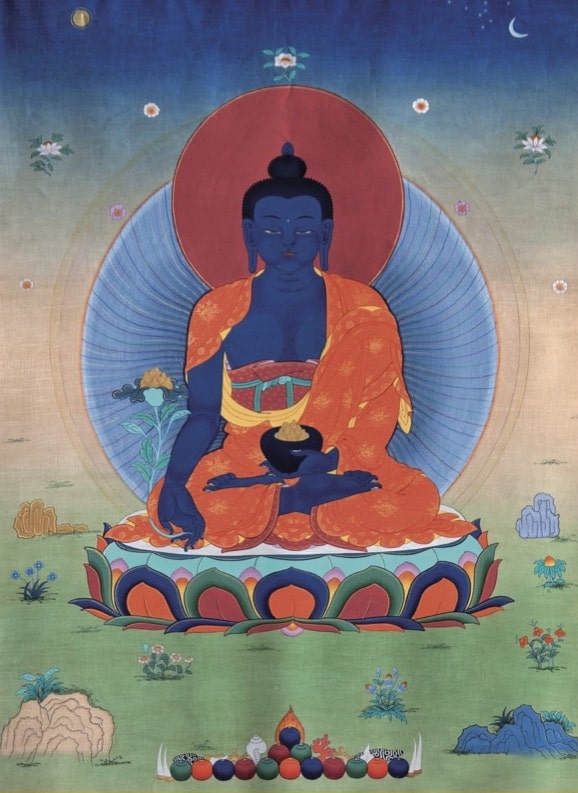Medicine Buddha, or Bhaiṣajyaguru visualization has been practiced in many forms of Mahayana and Vajrayana Buddhism. According to the Mahayana Bhaiṣajya-guru-vaiḍūrya-prabhā-rāja Sūtra, the bodhisattva Bhaiṣajyaguru made twelve great vows. In particular, he aspired that he be able to heal all beings’ physical sufferings and mental illnesses. Moreover, he vowed to relieve them from the sufferings of hunger, thirst, and destitution. When through his practice he reached enlightenment, his supreme aspirations were fulfilled. Thus he became endowed with the power to help heal and dispel those sufferings. Therefore, for those suffering from various temporary or critical illnesses, the practice of Medicine Buddha is extremely relevant and beneficial.
Medicine Buddha Visualization
In the Tibetan tradition, Medicine Buddha is described as being dark blue (lapis lazuli). Lapis has historically been valued as a healing substance, and the deep blue is an archetypal healing color. In his left hand he holds a medicine bowl full of healing ambrosia. And in the right hand, he holds a medicine plant. You may come across many visual presentations of Medicine Buddha, from the Tibetan, Chinese, and Japanese traditions, but they all tend to include this iconography.
This practice may be performed in a very simple way to ease both physical and mental suffering. When we experience disease, physical pain, anxiety, depression, stress or fear we bring to mind the Medicine Buddha. So, we imagine him seated above the crown of our head. Of course, we can also perform this visualization to benefit any other being—we imagine the Medicine Buddha above the head of that individual. In order to gain familiarity, take some time to study an image—but visualize the buddha’s form as insubstantial—a transparent body of light. Think then that brilliant rays of healing light emanate from the buddha’s body, falling like a liquid rain of medicinal nectar. As these rays fill our own body (or the body of the individual that we wish to practice for) they purify illness and suffering of any type.
Alternatively, we might imagine the Medicine Buddha within the body at the specific site of physical pain and suffering. In the same way as before, we then visualize healing light rays infusing that location, bringing health and ease to the body or mind.

As the embodiment of healing energy, the Medicine Buddha manifested for the benefit of all beings. His healing powers are transmitted in manifold ways, through all sense perceptions. Thus, according to Tibetan texts, we can benefit from his blessings in eight ways: sight, sound, contact, taste, wearing, touch, smell, and inhalation. Our partners at Akara Collection have brought together a collection, The Eight Jewels of Healing, that include the healing substances as described in classical texts.
Visualization, Mantra and Science
Scientists have recently begun to study the effects of meditation on pain and suffering. Individual studies are ongoing in such fields as coronary care, diabetes, PTSD, and chronic pain. Although this research is still developing, there is sufficient data to show that both mindfulness and healing visualization meditations can be effective in reducing stress, inflammation, and perception of pain. Some studies indicate that such meditations help produce endorphins, seratonin, melatonin, and other chemicals that produce physical changes. And the combination of mantra recitation and visualization seems to aid the practitioner in maintaining focus, thus allowing these changes to occur.
As with any practice, confidence plays a crucial role in effectiveness. And if we practice while believing that that visualization and mantra bring benefit, then there is more reason to anticipate success. As we are learning from scientific studies, placebo effects do account for a significant percentage of all healing success.
Chenrezig: The Embodiment of Compassion
In this video, Tulku Migmar also mentions the benefits of reciting the mantra of Chenrezig, or Avalokiteśvara, the Buddha of Compassion. Famous throughout Mahayana literature, Avalokiteśvara is mentioned in the Lotus Sūtra with over 30 manifestations, all of who appear with compassion to aid beings. He is the compassionate bodhisattva who responds to the cries of all sentient beings—working tirelessly to benefit all who call upon his name.

In the Kāraṇḍavyūha Sūtra, we find the description of his famous six-syllable mantra, which is practiced extensively in Tibet. In this text, Śākyamuni Buddha praises this mantra as “the most beneficial mantra”, noting that it that it embodied the compassion of all the Buddhas. Thus, as practitioners of compassion, we can always turn to the practice of this mantra for its healing power.


